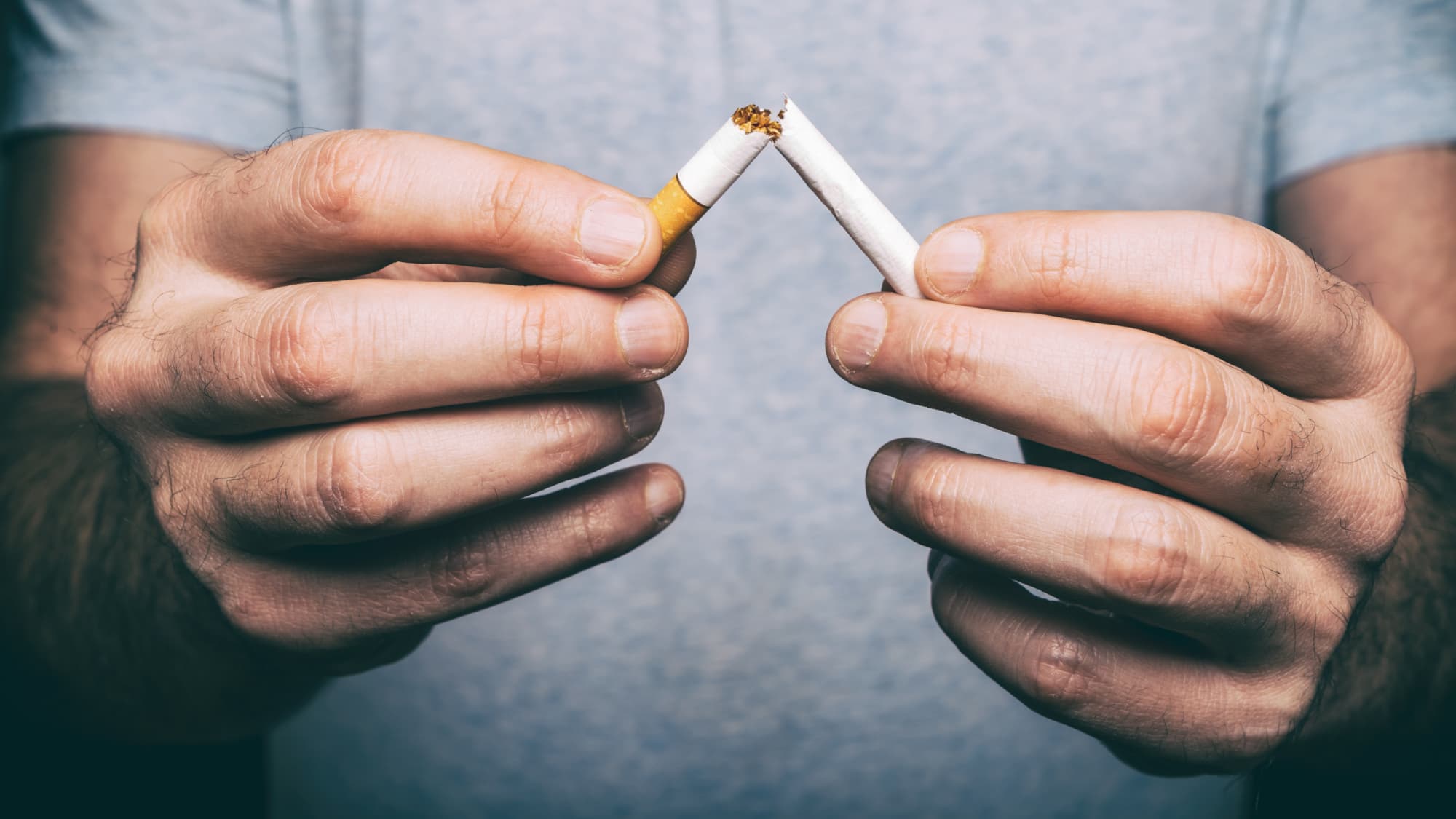Quitting Smoking
Why is smoking so addictive?
Smoking is highly addictive due to the presence of nicotine, a powerful psychoactive compound found in tobacco smoke. There are several reasons why nicotine is so addictive:
- Neurochemical effects: Nicotine triggers the release of dopamine and other neurotransmitters in the brain’s reward pathways, creating feelings of pleasure and reinforcing the desire to continue smoking. This dopamine release is similar to the effects of other addictive substances like cocaine or heroin.
- Rapid absorption: When smoke from a cigarette is inhaled, nicotine is rapidly absorbed into the bloodstream through the lungs and quickly reaches the brain within 10-20 seconds. This rapid delivery enhances its addictive potential.
- Desensitization and tolerance: With repeated exposure, the brain’s nicotine receptors become desensitized, leading to tolerance and the need for higher doses to achieve the same effects. This cycle perpetuates the addiction.
- Withdrawal symptoms: When a smoker tries to quit, they experience unpleasant withdrawal symptoms such as irritability, anxiety, difficulty concentrating, increased appetite, and cravings. These symptoms make it difficult to break the addiction and often lead to relapse.
- Behavioral and psychological factors: Smoking becomes associated with certain activities, emotions, or social situations, creating behavioral patterns and psychological cues that can trigger cravings and reinforce the addiction.
- Genetic predisposition: Research suggests that some individuals may have a genetic predisposition that makes them more susceptible to nicotine addiction, possibly due to variations in the brain’s reward pathways or nicotine metabolism.
- Early exposure and adolescent vulnerability: Smoking during adolescence, when the brain is still developing, increases the risk of developing a long-lasting addiction due to the heightened sensitivity to nicotine’s effects during this critical period.
The combination of nicotine’s powerful neurochemical effects, rapid delivery, tolerance development, withdrawal symptoms, behavioral associations, and individual genetic factors contribute to the highly addictive nature of smoking. Breaking this addiction often requires a combination of pharmacological treatments, behavioral therapies, and strong willpower and support.
How fast does nicotine leave the body?
The rate at which nicotine is eliminated from the body can vary depending on several factors, but generally, nicotine has a relatively short half-life. Here’s an overview of how fast nicotine leaves the body:
- Blood and saliva:
- Nicotine is rapidly absorbed into the bloodstream when inhaled from cigarette smoke.
- The half-life of nicotine in the blood and saliva is approximately 2 hours.
- This means that after 2 hours, half of the nicotine in the blood and saliva is eliminated from the body.
- Urine:
- Nicotine and its metabolites (byproducts) are excreted through urine.
- The half-life of nicotine in urine is around 4-6 hours.
- Nicotine and its metabolites can be detected in urine for up to 3-4 days after the last exposure.
- Hair and nails:
- Nicotine and its metabolites can be incorporated into hair and nails during their growth.
- These substances can remain detectable in hair for several months and in nails for up to a few weeks after the last exposure.
- Factors affecting elimination rate:
- Metabolism: Individuals with faster metabolisms tend to eliminate nicotine from their bodies more quickly.
- Age: Older individuals generally eliminate nicotine more slowly than younger individuals.
- Liver function: Since nicotine is metabolized in the liver, individuals with impaired liver function may eliminate nicotine more slowly.
- Pregnancy: During pregnancy, the clearance of nicotine from the body is slower.
- Secondhand smoke exposure: Exposure to secondhand smoke can prolong the presence of nicotine and its metabolites in the body.
It’s important to note that while nicotine itself is eliminated relatively quickly, the physical and psychological cravings and withdrawal symptoms associated with nicotine addiction can last much longer, making it challenging for smokers to quit.
For most smokers, it typically takes several days to a week for the majority of nicotine and its metabolites to be eliminated from the body after quitting. However, traces of nicotine exposure can still be detected in hair or nails for an extended period.
What are some hard ways to quit smoking?
Quitting smoking can be challenging, but there are several effective methods and strategies that can help increase the chances of success. Here are some ways to quit smoking:
- Nicotine replacement therapy (NRT):
- NRT provides a low level of nicotine without the other harmful chemicals found in cigarette smoke.
- Options include nicotine patches, gum, lozenges, inhalers, and nasal sprays.
- NRT can help manage withdrawal symptoms and cravings.
- Prescription medications:
- Medications like bupropion (Zyban) and varenicline (Chantix) can help reduce cravings and withdrawal symptoms.
- These medications work by blocking the effects of nicotine or reducing the pleasure derived from smoking.
- Behavioral therapies:
- Cognitive-behavioral therapy (CBT) can help identify and change thoughts and behaviors related to smoking.
- Counseling and support groups provide strategies for coping with cravings and stress management.
- Gradual reduction or “cutting down”:
- Gradually reducing the number of cigarettes smoked each day can help prepare for quitting.
- Setting a quit date and sticking to a reduction schedule can increase the chances of success.
- Cold turkey (abrupt cessation):
- Quitting smoking completely and abruptly without any aids or gradual reduction.
- This method requires strong willpower and determination but can be effective for some individuals.
- Combination approach:
- Using a combination of methods, such as NRT and behavioral therapy, can increase the chances of success.
- Combining medications with counseling or support groups can provide a comprehensive approach.
- Lifestyle changes:
- Regular exercise and physical activity can help manage withdrawal symptoms and cravings.
- Avoiding triggers and high-risk situations that prompt the urge to smoke.
- Finding healthy alternatives to replace the habit of smoking, such as chewing gum or drinking water.
- Support system:
- Enlisting the support of family, friends, or a quit-smoking buddy can provide encouragement and accountability.
- Joining online or in-person support groups can offer a sense of community and shared experiences.
It’s important to note that quitting smoking is a journey, and it may take multiple attempts before achieving success. Being patient, seeking professional help if needed, and staying motivated can increase the chances of successfully quitting and remaining smoke-free in the long term.
What are the health benefits of quitting smoking?
Quitting smoking can provide numerous significant health benefits, both in the short term and long term. Here are some of the main health benefits of quitting smoking:
Short-term benefits:
- Improved circulation and lung function: Within a few weeks of quitting, circulation improves, and lung function increases, making it easier to breathe.
- Reduced risk of respiratory infections: The risk of contracting respiratory infections, such as bronchitis and pneumonia, decreases soon after quitting.
- Enhanced senses of smell and taste: As the body rids itself of the chemicals in cigarette smoke, the senses of smell and taste can improve within a few days.
Long-term benefits:
- Reduced risk of cardiovascular diseases: Quitting smoking significantly lowers the risk of developing cardiovascular diseases, such as heart attacks and strokes, over time.
- Decreased risk of lung cancer and other cancers: Smoking is a major risk factor for lung cancer, and quitting can greatly reduce the risk. The risk of developing other cancers, such as mouth cancer, throat cancer, and bladder cancer, also decreases over time.
- Improved respiratory function: Lung function can continue to improve for years after quitting, reducing the risk of chronic obstructive pulmonary disease (COPD) and other respiratory problems.
- Lower risk of fertility issues and pregnancy complications: Quitting smoking can improve fertility in both men and women and reduce the risk of complications during pregnancy.
- Better overall health and increased life expectancy: Smokers who quit before the age of 40 can regain almost a decade of life expectancy compared to those who continue smoking.
Other benefits:
- Better quality of life: Quitting smoking can lead to improved overall physical and mental well-being, increased energy levels, and a better quality of life.
- Financial savings: Quitting smoking can save a significant amount of money that would have been spent on cigarettes.
- Reduced exposure to secondhand smoke: By quitting, individuals also protect their family and loved ones from the harmful effects of secondhand smoke.
It’s important to note that the sooner an individual quits smoking, the faster they can experience these health benefits and reduce the risks associated with smoking-related diseases.
What is the one easy way to quit smoking?
I had no interest in quitting smoking, but one of my employees left a copy of Allen Carr’s “Easy Way” at my house. I read it and half way through I knew I was cured of smoking. Buy it for yourself or gift it to a smoking friend. It works.




